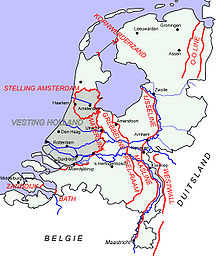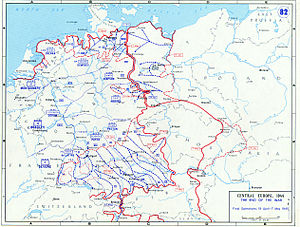- National redoubt
-
A national redoubt is a general term for an area to which the (remnant) forces of a nation can be withdrawn if the main battle has been lost—or even beforehand if defeat is considered inevitable. Typically a region is chosen with a geography favouring defence, such as a mountainous area or a peninsula, in order to function as a final hold-out to preserve national independence for the duration of the conflict.
Contents
France and the Low Countries
From the middle of the 19th century until 1914 the fortress city of Antwerp was the official National Redoubt of Antwerp in Belgium, and until 1940, the "Fortress Holland" was that of the Netherlands, although in neither case did the "redoubt" prove defensible — even though the same area of Holland proper did manage to stop the advances of the French troops in the Rampjaar 1672, providing the Dutch with much-needed time to eventually gain the upper hand. In 1940 Brittany was briefly considered as such in the last stages of the Fall of France, but again proved impractical.
China
During the Second Sino-Japanese War in World War II, the city of Kunming was prepared as a national redoubt in case the temporary capital in Chongqing fell, an elaborate system of underground caves to serve as offices, barracks and factories was prepared but never utilized.
Kunming was again to have served in this role in the renewed Chinese civil war, but the Nationalist garrison changed sides and joined the Communists. Instead, Taiwan became the last redoubt and home of the Nationalist government, a role which continues to this day.[1]
Nazi Germany
The Alpine Fortress (German: Alpenfestung) was the World War II national redoubt planned by Heinrich Himmler in November/December 1943[2] for Nazi Germany's retreat to an area from "southern Bavaria across western Austria to northern Italy".[3] The plan was never fully endorsed by Hitler and no serious attempt was made to put the plan into operation.
In the six months following the D-Day landings in Normandy in June 1944, the American and British armies advanced to the Rhine and seemed poised to strike into the heart of Germany, while the Soviet Army, advancing from the east through Poland, reached the Oder. It seemed likely that Berlin would soon fall and Germany be cut in half. In these circumstances, it occurred both to some leading figures in the German regime and to the Allies that the logical thing for the Germans to do would be to move the government to the mountainous areas of southern Germany and Austria, where a relatively small number of determined troops could hold out for some time. A number of intelligence reports to the Supreme Headquarters of the Allied Expeditionary Forces (SHAEF) identified the area held stores of foodstuffs and military supplies built up over the preceding six months, and could even be harbouring armaments production facilities. Within this fortified terrain, they said, Hitler would be able to evade the Allies and cause tremendous difficulties for the occupying Allied forces throughout Germany.
The Nazi Germany minister for propaganda, Joseph Goebbels, set up a special unit to invent and spread rumours about an Alpenfestung. Goebbels also sent out rumours to neutral governments, thus keeping the Redoubt myth alive and its state of readiness unclear. He enlisted the assistance of the intelligence service of the SS, the SD, to produce faked blueprints and reports on construction supplies, armament production and troop transfers to the Redoubt. For Germans, the Redoubt became part fantasy and part official deception plan.
Although Adolf Hitler never endorsed the plan, he issued an order on April 24 for the evacuation of remaining government personnel from Berlin to the Redoubt; he made it clear that he would not leave Berlin himself, even if it fell to the Soviets, as it did on May 2. When the American armies penetrated Bavaria and western Austria at the end of April, they met little serious resistance, and the National Redoubt was shown to have been a myth.
Nevertheless the National Redoubt had serious military and political consequences. Once the Anglo-American armies had crossed the Rhine and advanced into western Germany, they had to decide whether to advance on a narrow front towards Berlin, or on a broad front, with a view to securing both the North Sea coast and southern Germany before advancing further. The American commander, General George S. Patton, had consistently advocated a narrow front ever since D-Day, and did so again at this point. But the Allied commander in chief, U.S. General Dwight Eisenhower, took a more cautious view, and the broad front strategy prevailed.
Goebbels' deception plan over the Redoubt was one of the great successes of German intelligence during World War II, albeit one that came too late to alter the outcome of the war. The Allied intelligence services were completely fooled by Goebbels' false trail of rumours.
The Alpine Fortress was one of three reasons associated with SHAEF's movement of forces towards southern Germany rather than towards Berlin (cf. Berlin was planned to be in the Soviet Zone of Occupation and the Battle of Berlin would entail unacceptably high Western Allied casualties).
Evacuations to the Alpine Fortress
- February/early March 1945, SHAEF received reports that German military, government and Nazi Party offices and their staffs were leaving Berlin for the area around Berchtesgaden, the site of Hitler's retreat in the Bavarian Alps.
- In February 1945, the SS evacuated V-2 rocket scientists from the Peenemünde Army Research Center to the Alpine Fortress.
- SS Generalleutnant Gottlob Berger claimed Hitler had signed a 22 April 1945 order to evacuate 35,000 prisoners to the Alpine Fortress as hostages, but Berger did not carry out the order[4] (many evacuated locations also failed to obey Hitler's order requiring Demolitions on Reich Territory, e.g., Mittelwerk).
Post-war claims
Post-war claims regarding the Alpine Fortress include:
- The Alpine Fortress "grew into so exaggerated a scheme that I am astonished we could have believed it as innocently as we did. But while it persisted, this legend of the Redoubt was too ominous a threat to be ignored." (General Omar Bradley)[citation needed]
- Allied assessments of the Alpine Fortress were "the worst intelligence reports of all time, but no one knew that in March of 1945, and few even suspected it." (author Stephen E. Ambrose)[citation needed]
Yugoslavia
According to the "Total National Resistance" defense doctrine of the second Yugoslavia, a rugged highland area roughly encompassing Bosnia was to function as a redoubt to which the Yugoslav People's Army would retreat in case of a Soviet or NATO invasion. Defense of the rest of the country was to be left to the guerrilla-warfare efforts of the Territorial Defense forces. A network of fortified bases was developed in anticipation, including an underground air force base at Željava and a command bunker complex intended for the use of Marshal Josip Broz Tito.
Switzerland
Swiss National Redoubt (Schweizer Alpenfestung or Réduit suisse) was a defensive plan developed by the Swiss government during World War II to respond to a possible German invasion, which had been planned but was never carried out.
The plan was three staged, first to hold an invading army on the border, if that failed to launch a delaying war that would allow the bulk of Swiss forces to withdraw to a defensible perimeter in the Swiss Alps, and three to defend that mountain stronghold.[5]
Austria
During the Cold War, Austria developed a similar plan called Raumverteidigung (area defense). The plan was primarily directed against Hungary and Czechoslovakia (and later the Warsaw Pact) but it also included plans against an attack by NATO forces. The Austrian Armed Forces would retreat into key zones situated in the alpine region and defend it. They would also employ guerilla warfare behind enemy lines and delay the enemy advance in the area's security zones.[6][7]
Fictional
The concept of a "last stand" national stronghold also appears in fictional works, perhaps most famously in J.R.R. Tolkien's The Two Towers. In that book the people of Rohan, fearing an attack of superior numbers by the armies of Isengard, leave their capital city of Edoras to take refuge in the fortress of Helm's Deep. Tolkien also uses the concept in The Return of the King, where during the Siege of Minas Tirith most of the civilian populace retreats to the vales of the White Mountains, while the majority of the military holds up in Minas Tirith.
See also
- Battle of Berlin
- The Brisbane Line
- The March (1945)
- Masada
- Partisan (military)
- Réduit
- Redoubt
- Werwolf
Notes
- ^ "Last Stand". Time magazine. December 19, 1949. http://www.time.com/time/magazine/article/0,9171,855050,00.html?iid=chix-sphere. Retrieved 2007-12-03.
- ^ Gallagher, Wes (Associated Press Correspondent) (Dec. 13, 1944). "Nazis Prepared for Five Years Underground Warfare". The Evening Independent (St. Petersburg, Florida). http://news.google.com/newspapers?id=EKYLAAAAIBAJ&sjid=F1UDAAAAIBAJ&pg=3767,1446383. Retrieved 2010-12-22. "Himmler started laying the plans for underground warfare in the last two months of 1943.... The plans are threefold, embracing (1) Open warfare directed from Hitler's mountain headquarters; (2) Sabotage and guerrilla activity conducted by partisan bands organized by districts, and (3) Propaganda warfare to be carried on by some 200,000 Nazi followers in Europe and elsewhere. Strongholds Established Already picked S.S. (elite) troops have been established in underground strongholds and hospitals in the Austrian, Bavarian and Italian Alpine area and it is the plan of Nazi leaders to flee to that region when the German military collapse comes."
- ^ Time. February 12, 1945. http://www.time.com/time/magazine/article/0,9171,852130-4,00.html. "But what of the top Nazis who cannot hide? With a compact army of young SS and Hitler Youth fanatics, they will retreat, behind a loyal rearguard cover of Volksgrenadiere and Volksstürmer, to the Alpine massif which reaches from southern Bavaria across western Austria to northern Italy. There immense stores of food and munitions are being laid down in prepared fortifications. If the retreat is a success, such an army might hold out for years."
- ^ The Last Escape - John Nichol, Tony Rennell - 2002 Penguin UK
- ^ http://strangemaps.wordpress.com/2007/05/07/109-the-schweizer-reduit-hard-core-switzerland/ Strange Maps
- ^ http://www.globalsecurity.org/military/world/europe/at.htm
- ^ http://www.bmlv.gv.at/omz/ausgaben/artikel.php?id=302
Categories:- World War II deception operations
Wikimedia Foundation. 2010.



